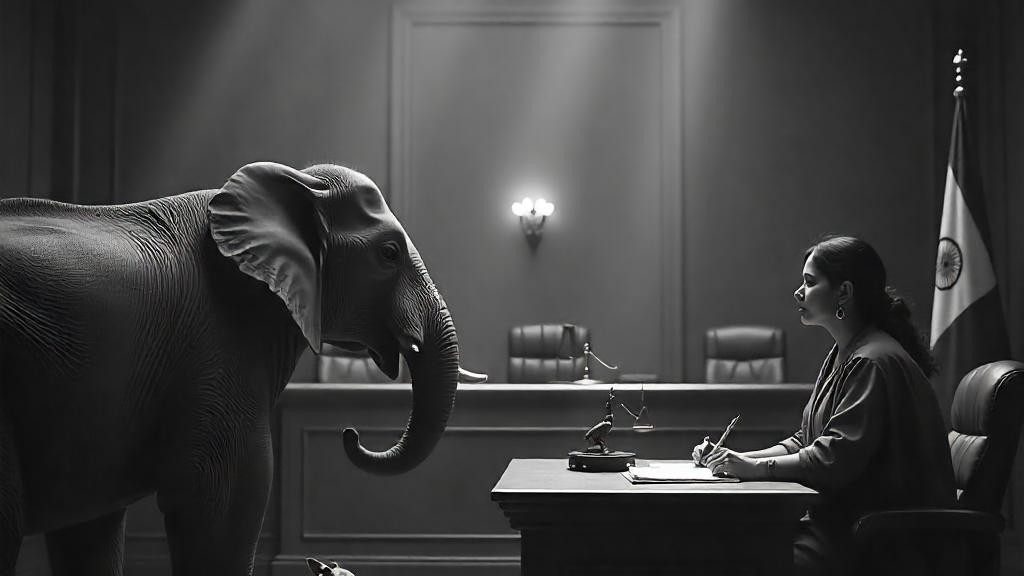Introduction: The Legal Evolution of Compassion
The question "Can an animal be a person in the eyes of the law?" might have seemed rhetorical a few decades ago. However, today marks the intersection of ethics, law, and civilisation. Modern legal systems are undergoing a seismic shift: moving away from anthropocentric legal frameworks that view animals as property, toward biocentric and ecocentric models that treat animals as rights-bearing legal persons. This evolution is not just jurisprudential—it is civilizational, reflecting our collective maturity and expanding our moral universe.
In India, the last decade has witnessed a surge in judicial activism on behalf of animal rights. But without comprehensive statutory backing, the status of animals as legal persons remains precariously balanced between progressive judgments and outdated laws.
II. Understanding Legal Personhood: A Theoretical Primer
Legal personhood is a juristic fiction that enables both humans and artificial entities (like corporations or trusts) to hold rights and duties, sue and be sued, or own property.
🔑 Key Characteristics of Legal Personhood:
- Independent legal identity
- Right to legal representation
- Subject of responsibilities (in limited contexts)
Legal personhood does not require sentience. Rivers, idols, and companies are legal persons in India—so why not animals?
The recognition of animals as legal persons thus aligns not only with ethics but also with established legal logic.
III. Judicial Recognition in India: From Welfare to Personhood
🧑⚖️ 1. Animal Welfare Board of India v. A. Nagaraja (2014, SC)
- The SC banned Jallikattu, citing cruelty and violation of the PCA Act.
- Introduced the idea of "speciesism" and recognized animal dignity.
- Held that Article 21 (Right to Life) must be read expansively to include animal welfare.
- Introduced the "Five Freedoms" as a legal standard:
🧑⚖️ 2. Narayan Dutt Bhatt v. Union of India (2018, Uttarakhand HC)
- All animals are declared "legal entities" with corresponding rights and duties.
- People declared "loco parentis" (guardians) of animals.
- The court drew an analogy from New Zealand's recognition of rivers as legal persons.
🧑⚖️ 3. Karnail Singh v. State of Haryana (2019, P&H HC)
- Reinforced the legal personhood status of animals.
- The court held that animals cannot be treated merely as property.
- Animals have "constitutional rights to live with dignity".
IV. Comparative Global Jurisprudence
🌍 International Trends:
Country Legal Recognition Example: Ecuador. The Constitution grants nature and animals the right to exist, as embodied in the Rights of Pachamama (Mother Earth). Colombia: Animal rights enforced through constitutional litigation in the "Justice for Chucho the Bear" case. New Zealand: Recognised the Whanganui River as a legal person—Treaty of Whanganui. The USANonhuman Rights Project filed a habeas corpus for chimps (Lost due to a lack of precedent). PakistanIslamabad HC granted animal personhood in zoo case, Justice Athar Minallah's ruling
These examples show that India is not alone in this jurisprudential experiment. A global rights-of-nature movement is sweeping across constitutional courts.
V. Constitutional & Statutory Landscape in India
🧾 Constitutional Provisions:
· Article 21 – Right to life interpreted to include animal dignity.
· Article 48A – The State shall protect the environment and wildlife.
· Article 51A(g) – Duty of citizens to protect animals and forests.
📜 Statutes:
· The Prevention of Cruelty to Animals Act, 1960 – Primary welfare law, but heavily outdated.
· Wildlife Protection Act, 1972 – For wild animals only; doesn't grant personhood or dignity.
· Food Safety Act & Transport Rules – Implicit welfare standards but no rights language.
❗ Legislative Gaps:
· No comprehensive Animal Rights Code
· No formal definition of animal personhood
· Outdated penalties: Max ₹100 for extreme cruelty under PCA
VI. The Ethical and Legal Dilemmas of Personhood
⚖️ Practical Conflicts:
Conflict Area Ethical Issue Legal Complexity Agriculture Animal slaughter vs. sentient rights Legal person cannot be killed for profit Scientific Testing Use of animals for research Conflict with "freedom from pain" Pet Ownership Guardianship vs. Ownership Is pet ownership a form of slavery? The use of animals in circuses and films violates their autonomy and natural behaviour. Religious Practices: Ritual slaughter, offerings. Fundamental rights vs. animal rights
VII. Guardianship & Enforcement Mechanism
Legal personhood raises the doctrinal question of representation:
· Who can file a case on behalf of animals?
· Can a legal guardian sue a government body for allowing cruelty?
This area requires a structured legal framework akin to:
· Juvenile Justice Act model
· Public Guardian Offices
· Writ jurisdiction by PIL
VIII. The Future of Animal Rights in India
📌 Proposals for Legal Reform:
1. Amend the PCA Act to:
2. Establish an Animal Rights Commission (on the lines of NHRC)
3. Grant standing to recognised NGOs to represent animals
4. Constitutional Amendment recognising "Nonhuman Rights"
5. National Register for Animal Guardianship
🎓 Possible Research Hypotheses:
· "Legal personhood for animals creates a conflict between food security and ethical law."
· "The constitutional morality doctrine must include animal dignity."
· "India's recognition of animal personhood must be codified to prevent judicial overreach."
IX. Conclusion: Toward a New Legal Consciousness
Recognising animals as legal persons isn't about putting animals above humans—it's about placing compassion into law. As we step into the Anthropocene, where human activity defines the fate of every species, the law must rise above its human-centric origins. Legal personhood offers the first stepping stone to a future where dignity, not dominance, defines our relationship with nature.
India's courts have demonstrated bold leadership, but this boldness must be accompanied by clarity, consistency, and codification to ensure effective implementation. For the legal revolution to be complete, the Parliament must now give voice to the voiceless.
📚 Suggested Bibliography
1. Justice K.S. Radhakrishnan's opinion in A. Nagaraja judgment
2. Law Commission Report No. 261: "Need to Review Animal Welfare Laws"
3. Articles by Prof. Upendra Baxi on Constitutional Personhood
4. Nonhuman Rights Project (USA) litigation archive
5. Judith Koons, "Earth Jurisprudence and Rights of Nature"
6. Animal Law Centre, NALSAR University of Law

